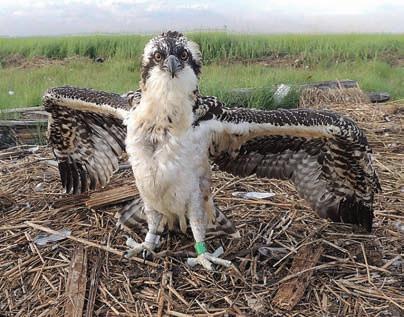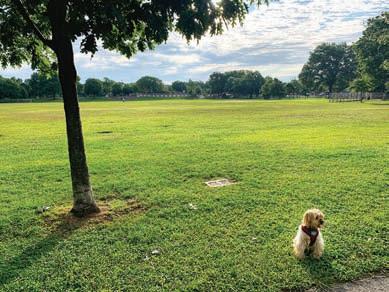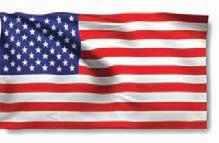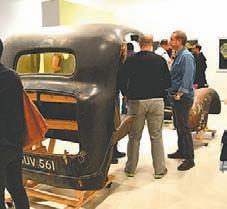
11 minute read
Parks & Recreation
2021 Plenty of choice space for your
Queens is blessed with dozens of parks large and small, for everything from taking a leisurely stroll to seeking out wildlife to playing organized sports. Here are brief rundowns on some of the biggest and best, as described by the City of New York and, in the case of Jamaica Bay, the National Park Service.
ALLEY POND PARK 69-70 230 St., Oakland Gardens
Alley Pond Parkhas all the amenities you’d expect from a neighborhood park — playgrounds, barbecue areas and courts and fields galore! It also offers glimpses into New York’s geologic past, its Colonial history and its current conservation efforts with numerous unique natural features,like its freshwater and saltwater wetlands, tidalflats, meadows and forests, which create a diverse ecosystem and support abundant bird life.
It is home to New York City’s first public high ropes adventure course (the largest in the Northeast), part of the Urban Park Rangers’ larger Alley Pond Park Adventure program. A low-cost outdoor education and adventure program, Alley Pond Park Adventure teaches participants how to canoe, use a compass, fish and enjoy a natural setting without leaving the city.
ASTORIA PARK 24-02 19 St., Long Island City
Widely known for its beautiful pool, the oldest and largest in the city, Astoria Park offers more than aquatic pleasures. Outdoor tennis courts, a track, a bandstand, multiple trails, basketball courts and playgrounds lure visitors from the five boroughs and beyond. And the views! Sitting on the edge of the East River and resting between the Triborough Bridge and Hell Gate Bridge, the park offers shoreline sights and sounds that make the benches along its perimeter popular spots year-round.
The 56-acre park has been expanded. Phase one rehabilitated the playground in the park’s southern section, the park fields and the drainage system. Phase two restored the comfort station and installed new play equipment, swings, drinking fountains and game tables.
Phase three focused on restoration of the park’s northeast section and included repaving all the roads and walkways, rerouting pedestrian entrances, installing new benches and planting trees, shrubs and groundcover.
The inviting setting of Astoria Park remains rich in history and symbolic of an ever-changing New York City.
BAISLEY POND PARK North Conduit and 116th avenues between 150th Street, Sutphin Boulevard and Baisley Boulevard South, Jamaica
Baisley Pond Park is a great place to play tennis, handball, basketball and cricket, with spaces to run, bike and rollerblade.
It offers playgrounds for your child’s enjoyment, peaceful, shady alcoves for picnicking and an urban natural habitat for your own study of plant and animal life. There’s a good chance you can find your niche at Baisley Park.
Forest Park
BOWNE PARK 155-01 32 Ave., Flushing
Bowne Park offers recreation for all age groups. It boasts a bocce court surrounded by benches and tables, modern playground equipment, slides, swings, a spray shower and basketball courts.
The parkhouse, crowned by a weather vane, includes a community room that doubles as a nursery. Beautiful bench-lined walkways provide space for relaxing. The park features a pond that is home to families of turtles. A cement turtle, set atop the rolling hills overlooking the pond, stands guard above his more lively counterparts as they navigate the waters below. Two weeping willows, measuring nearly 50 feet in height, stand adjacent to the pond.
In addition, American elms and oaks shade the park during the summer months with their wide canopies. The John Bowne homestead, located at 37-01 Bowne St., lies south of the park and remains the oldest private residence in the borough.
BROOKVILLE PARK 232-236 Edgewood Ave., Rosedale
Brookville Park offers playgrounds with spray showers, barbecuing areas, baseball fields, bicycling, bocce courts, handball courts and tennis courts.
CROCHERON PARK 214 Place, Cross Island Parkway 35th Avenue, Bayside
Crocheron Park has picnic grounds, winding walks, an enlarged lake for wintertime skating and thousands of trees. Some of the species found in the park are northern catalpa (Catalpa speciosa), American elm (Ulmus americana), honey locust (Gleditsia triacanthos), sycamore maple (Acer pseudoplatanus), red oak (Quercus rubra), Japanese black pine (Pinus thunbergiana), London planetree (Platanus x acerifolia) and weeping willow (Salix alba ‘Tristis’).
There are also a dozen tennis courts, a baseball diamond and a field house.
Visitors can also take in the views of Little Neck Bay from either Cunningham Park

of the hexagonal gazebos that stand on the bluff.
The park undertook a major renovation of Golden Park in 1973, when the goldfish pond was restored and a tennis house, tennis courts, playground and six baseball fields were built. Together, Golden Park and Crocheron Park provide the neighborhood with a large area for recreation.
CUNNINGHAM PARK 196-10 Union Tpke.,Fresh Meadows
T he roll ing terrain of Cunningham Park was carved out by glaciers nearly 20,000 years ago. Today it provides a tree-lined path for walkers, joggers and bicycle riders, tennis courts, playgrounds, stables, bridle paths, playing fields, picnic groves and parking lots.
Cunningham Park is a treasured neighborhood resource that features diverse recreational facilities and an extensive calendar of special events. Annual events include appearances by the New York Philharmonic and the Metropolitan Opera.
ELMHURST PARK Grand and 57th avenues between 74th and 80th streets, Elmhurst
Elmhurst Park features lush lawns, jogging paths, seating, sculpture, modern comfort stations, safety lighting and more than 620 trees. The playground, designed for tots and young children, is energy-themed, in keeping with the site’s history. At the playground children can pedal a stationary bike to provide a light effect on a nearby column. The new Vietnam Veterans Memorial opened late last year. FLUSHING MEADOWS CORONA PARK Grand Central Parkway, Whitestone Expressway between 111th Street and College Point Boulevard, Park Drive East
The site of two 20th-century World’s Fairs attendedby millions of people, Flushing Meadows Corona Park continues to draw and delight countless visitors. As the largest park in Queens, it offers plenty of space for whatever your recreational desires may be — baseball, soccer, tennis or cricket.
And much more is available, including a stunning recreation complex, a zoo, an art museum, a botanicalgarden, a science museum and a baseball stadium. Explore one of the park’s six playgrounds, take a stroll along the Flushing Bay Promenade, rent a paddleboat to go out on Meadow Lake or launch your model airplane. Flushing Meadows Corona Park has room for all your active pursuits!
FOREST PARK 83-98 Forest Pkwy., Glendale
Forest Park is one of the natural treasures of New York City. Within Forest Park is the Overlook, the administration building for Queens Parks, and Oak Ridge, the former golf course clubhouse and current administration building for Forest Park.
Forest Park also offers a wide array of recreational facilities, such as the George Seuffert Sr. Bandshell, the carousel, the bridle path, tennis courts, playgrounds and Victory Field. Annual events include the Halloween Walk, the Victorian Christmas, Nature Trails Day, orienteering and battle re-enactments, which draw the participation of the surrounding neighborhoods of Kew
outdoor recreation
Gardens, Woodhaven, Richmond Hill, Forest Hills and Glendale.
Forest Park is the third-largest park in Queens and contains the largest continuous oak forest in Queens and a 110-acre golf course.

FORT TOTTEN PARK 422 Weaver Ave, Bayside
A pristine stretch surrounding a preserved Civil War fortress, Fort Totten Park provides not only recreation and relaxation but a fascinating glimpse into New York’s past. Year-round, New Yorkers flock to Fort Totten Park to enjoy its special events, natural wonders andhistoric buildings.
On hot summer days swimmers can take a dip in the pool and sunbathe around its grassy edges, or take canoes out and paddle along the Long Island Sound. Come Halloween, thousands are spooked by its enormous haunted “house,” located in the old water battery. During the winter, bird enthusiasts congregate to watch migrating waterfowl rest before their long journey south. And exploring the fortress and its surrounding buildings remains a unique adventure during any season.
Urban Park Rangers lead regular toursof the fortressandthe wildlife surrounding it for those who enjoy guided treks, and a visitors’ center inside the park provides helpful information on the park’s past for those prefer to scout alone.
HIGHLAND PARK Jackie Robinson Parkway, Vermont Avenue, Highland Boulevard between Bulwer Place and Cypress Hills Street, Cypress Hills
Conveniently located on a high plateau that straddles Queens and Brooklyn, Highland Park offers stunning views of the Ridgewood Reservoir, the Rockaways, the Atlantic Ocean and nearby cemeteries.
The park is a popular spot among residents of both boroughs and continues to play an important role in the community. Children’s farm gardens act as hands-on classrooms, barbecue areas serve as meeting grounds for mass celebrations, and numerous tennis courts, baseball fields, handball courts and basketball courts provide New Yorkers with safe, clean spots for athletic recreation.
The pathway around the basins is heavily usedby Brooklyn and Queens residents for walking and exercise. The reservoir boasts being home to more than 151 species ofbirds.
HUNTER’S POINT SOUTH PARK Center Boulevard between 50th and 54th avenues, LIC
This waterfront park, until recently an abandoned post-industrial area in Long Island City, has been transformed into a space that offers fun and relaxation for everyone in the area. The new park includes a central green, playground, dog run, bikeway, waterside promenade, a basketball court and a 13,000- square-foot pavilion that contains comfort stations, concessions and an elevated cafe plaza.
JAMAICA BAY UNIT, GATEWAY NATIONAL RECREATION AREA 175-10 Cross Bay Blvd., Broad Channel
Like pearls strung together, the Jamaica Bay Unit collects several areas surrounding Jamaica Bay in New York Harbor. It includes refuge areas for fish and migrating birds, wetlands protecting residents from damage during storms, former defense installations, beaches and playgrounds designed originally as New York City parks and the first municipal airport in the city.
The Jamaica Bay Wildlife Refuge was created from landfill in the 1950s and has become a birdwatcher’s paradise. More than 300 species of birds can be seen here during spring and fall migrations on the Atlantic flyway.
Frank Charles Park is a 20-acre parkdesigned in the 1940s as one of several neighborhood parks serving city residents. It contains athletic fields, a playground and more, and also preserves some of the remainingfringe marshes that ring Jamaica Bay, including a favorite place for horseshoe crabs.
Jacob Riis Park was designed by New York City as a park in 1912. World War I saw a change to defense needs when the U.S. Navy created a Naval Air Station, but its return to city hands saw its development into seaside recreation. Its famous beachhouse was built in 1932 and remodeled five years later.
Fort Tilden, at the edge of the Rockaways, served as a U.S. Army Coast Artillery Post from World War I into the Cold War. Today it is a favorite spot for fishing and shore recreation and team sports.


JUNIPER VALLEY PARK 71-01 Juniper Blvd., Middle Village
Juniper Valley Park is an integral part of its Middle Village neighborhood. Locals come to spend time with old friends and neighbors while groups gather to take full advantage of the tennis, handball and basketball courts. You might want to loop around the giant baseball field (2.25 laps/mile).
The park’s shuffleboard court is much beloved by the area’s older members, and the bocce courts are a legacy of the neighborhood’s active Italian community.The park is used by everyone from kids who want to learn to ride bikes to seniors taking a leisurely stroll together.
KISSENA PARK Fresh Meadows Lane, Kissena Boulevard, between Oak, Underhill and Booth Memorial avenues, Flushing Jamaica Bay Wildlife Refuge
Kissena Park is an ideal location to both relax and participate in fun outdoor activities. Flanked by weeping willows and shady trees the park creates an idyllic setting to enjoy a sunny day. Stroll through the park to take in all of the lush flora and fauna and be sure not to miss the historic tree grove. The dozens of species of trees in the grove are some of the most exotic in the world. In fact, the grove got its start as part of a 19th century horticultural nursery for the New York region.
Get active at one of the park’s many recreational facilities. Try and beat your best time on the bike at the park velodrome. Play a round of golf at the Kissena public course. And of course there are lots of playgrounds, baseball diamonds and tennis, handball and boccee courts for all to use.
QUEENSBRIDGE PARK Queensboro Bridge, 41st Road, 40th Avenue between the East River, Vernon Boulevrd and 21st Street, LIC
This park is named for the nearby Queensboro Bridge, which is also known as the Queensbridge or 59th Street Bridge. The 1960s band Simon and Garfunkel made the bridge famous in their song “Feelin’ Groovy,” also called “The 59th Street Bridge Song.”Facilities include barbecuing areas, baseball fields, dog-friendly areas, eateries, handball courts and playgrounds with spray showers.
TRAVERS PARK 33-16 78 St., Jackson Heights
Travers Park features a leaf-andvine shaped spray shower, benches and plantings, and a bicycle rack for the Jackson Heights community to use. The playground is fully-ADA compliant and is appropriate for children ages 5 to 10, and there are also basketball courts, game tables and picnic areas and areas for handball, tennis and roller hockey. With its amenities, it brings the Jackson Heights community together withplay equipment, athletic facilities, and attractive plantings andhorticulture.
Juniper Valley Park







